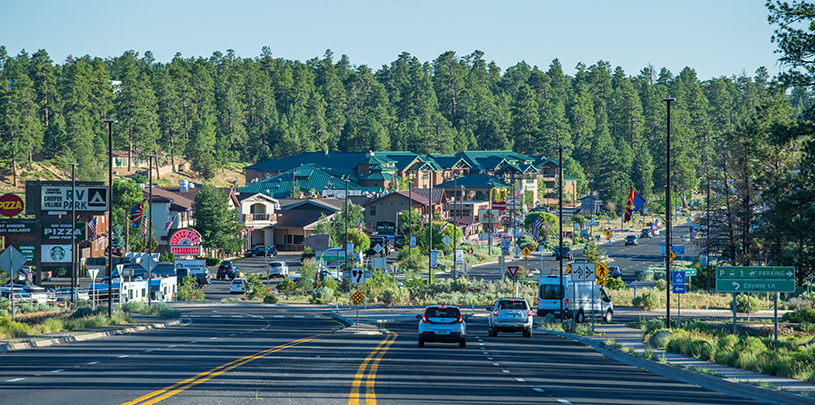
 by Lisa Winters, Communications Associate
by Lisa Winters, Communications Associate
Travel to the south rim of Grand Canyon National Park, and you’ll likely pass through the town of Tusayan on the way. You'll find two roundabouts, a handful of motels, and perhaps an elk wandering on the sidewalk. Though the population is small (less than 600), the gateway town of Tusayan caters to the more than 6 million annual visitors who travel from all over the world to see Grand Canyon National Park. As the park deals with increased visitation in an already overburdened area, Tusayan is hungry to grow. The biggest problem? Where to find water for all these people.
In the late 1980s, Tusayan, tired of hauling water from outside of town, dug its first well 3,000 feet deep to access groundwater from the Redwall-Muav Aquifer. This same aquifer feeds the springs and streams located beneath the canyon’s rim. Now, a private company wants to add thousands more faucets, tubs, and toilets to the mix. Before the developers can move forward, they need approval for roads and utility corridors through the Kaibab National Forest to the privately owned development sites.
This is a complicated project, so we’ve compiled answers to the most pressing questions about the proposed development.
Two private inholdings in the Kaibab National Forest are being proposed for development: Kotzin Ranch and TenX Ranch. Both are owned by the Stilo Development Group, a retail and property development company based out of Bergamo, Italy. Stilo supported the town of Tusayan’s incorporation in 2010.
The land that Stilo plans to develop is private, but it’s surrounded entirely by national forest lands. Dirt roads provide access to the private parcels. However, Stilo and the town of Tusayan have requested permission from the U.S. Forest Service to build about 5.5 miles of roads and infrastructure across these public lands in order to ensure four-season access and run utilities to these inholdings. They’re asking to pave the roads and install sewer lines, natural gas pipelines, telecommunications, and more. They expect 52 acres of national forest land to be disturbed.
Stilo’s vision for the 194-acre TenX Ranch, east of Tusayan, includes thousands of new housing units, a resort hotel, conference center, spa, dude ranch, retail stores, and other “supportive facilities.” The vast majority of the 160-acre Kotzin Ranch parcel, located west of Tusayan, would be established as a “visitor-centered campus” including lodging, commercial services, “edutainment” facilities, and shorter-term housing. Stilo also donated to the town 20 acres of land on each parcel for the development of affordable housing.
One thing that’s notably missing from the proposal? Details. While Stilo has adamantly stated that roller coasters, golf courses, and water parks are off the table, a marketing video produced by the company compared its vision to that of Epcot, a theme park at Disney World in Florida. The company has since taken the video down, but an edited copy can be found here ›
The forest supervisor for the Kaibab National Forest has already rejected Stilo’s proposal once, in 2016, citing its controversial nature, opposition by local and national communities, and impacts to tribal and national park lands. Former Grand Canyon National Park Superintendent David Uberuaga praised that decision, stating that it protects the park and its natural character. We agree: water, wildlife, sacred areas, and values essential to the Grand Canyon need to be taken care of, not used for private profit.
It’s no secret that water is scarce in Arizona. Commercial water demands for the proposed developments are estimated to be 275,000 gallons per day at peak season. Stilo says it won’t use any groundwater for new commercial establishments, but it’s unclear where this water will come from. The developers say they’ll truck in water (from who knows where), utilizing 6,000-gallon water trucks for hauling. If you crunch the numbers, during peak season that could be 45 large water truck deliveries rolling through town each day.
Back in 2015, the U.S. Department of the Interior warned that pumping groundwater could result in violation of the World Heritage Convention, an international agreement to protect outstanding areas of natural and cultural values. Additionally, the Havasupai Tribe, who has resided on the banks of Havasu Creek and within the Grand Canyon since time immemorial, relies heavily on this one water source — the Redwall-Muav Aquifer — for its people’s livelihoods.
As was the case in 2016, the Forest Service has the authority to not grant the easements necessary for development. The agency must consider a multitude of impacts on the landscape, including additional traffic, trash, noise, light pollution, and sewage. And all of these impacts would be on the doorstep of one of America’s most spectacular national parks.
80% of Arizona voters support Baaj Nwaavjo I'tah Kukveni National Monument, according to a new poll.
Read MoreThe Colorado River below Glen Canyon Dam is heating up. Find out why.
Read MoreGroundwater pumping at a uranium mine near the Grand Canyon will affect the canyon's springs, scientists says.
Read More